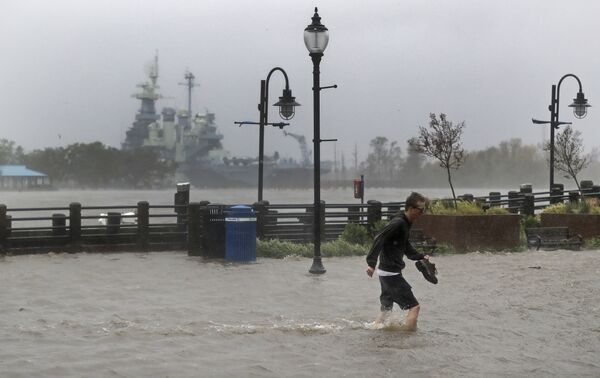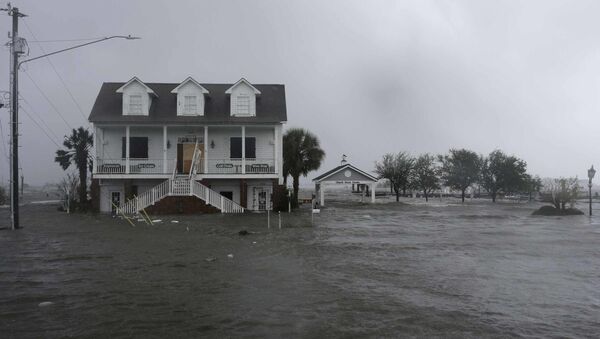Once the storm's eye was ashore, it quickly began to weaken, and by 5 p.m. local time was downgraded from a hurricane to a tropical storm, as its strongest sustained wind speeds fell below 75 mph, CBS noted.
Florence hits the Carolinas. Here are a few images from our journey around the area. @CBNNews #HurricanFlorence #NorthCarolina #WilmingtonNC pic.twitter.com/hsqneQVZRp
— Mario Gonzalez (@MariogphotoDC) September 14, 2018


Five people are dead in the Carolinas due to the storm, the Associated Press reported Friday evening.
A mother and her baby died when a tree fell on their home; an old woman died of a heart attack when emergency vehicles were unable to reach her home due to the storm; a man was electrocuted connecting extension cords outside his home; and an old man was killed when the storm forcefully blew him down while he was checking on his hunting dogs, The Weather Channel reported.
INTENSE rain band with tidal surge ramping back up inundating homes across New Bern, NC #HurricameFlorence @accuweather @breakingweather pic.twitter.com/5W8hpEZJdT
— Reed Timmer (@ReedTimmerAccu) September 14, 2018
Over 750,000 homes and businesses are without power as the storm tears down trees and electrical wires.
More damage just NW of Jacksonville, NC. #Stormtrack2 #HurricanFlorence @JeremyDanMoore @eddierandle pic.twitter.com/yhM0yEIjJ2
— Adam Vance 9News (@AdamVance9News) September 14, 2018
Nearly 2,100 flights have been cancelled through Saturday as a result of the storm.
In all, 11 million people live in the areas placed under storm watches and warnings by the National Weather Service.
@al_ratcliffe and I made our way up to Briarcliffe Acres this afternoon. By far, this is the worst tree damage we’ve come across. #HurricaneFlorence #Florence @WBTWNews13 #SouthCarolina pic.twitter.com/WNiZgRKsOX
— Meghan Miller (@Meghan_WBTW) September 14, 2018
As Florence's outer rain bands neared the eastern shores of the United States, the storm's powerful winds and low air pressure pushed the sea inland, forming record-high storm surges. At Cape Fear, North Carolina, the sea was 8.27 feet higher than normal, according to the National Weather Service. The sea was also pushed up rivers, meaning that even towns far from the coast have been inundated under feet of water.
Cape Fear River at Wilmington has reached an all-time high level of 8.27 feet — this beats past records from Matthew (8.2') and Hazel. pic.twitter.com/lgfGxwoQqv
— NWS Wilmington NC (@NWSWilmingtonNC) September 14, 2018
The NWS had issued flash flood emergencies across several North Carolina counties by Friday evening, citing the nearly two feet of rain that have already fallen in Carteret, Jones, Craven and Pamlico counties. Another 4 to 8 inches of rain is expected overnight.
Hurricane Florence @ midnight 9.13.18
— Michelle 🦄 (@chromatichues) September 14, 2018
Pungo River is raging across Belhaven, NC
Stay safe y’all! pic.twitter.com/zYbKCKBLnY
FEMA has carried out numerous water rescues, including one of over 150 people in New Bern, North Carolina, a riverfront town in Craven County, north of the eye of the storm but lashed by severe rain bands.
Currently ~150 awaiting rescue in New Bern. We have 2 out-of-state FEMA teams here for swift water rescue. More are on the way to help us. WE ARE COMING TO GET YOU. You may need to move up to the second story, or to your attic, but WE ARE COMING TO GET YOU. #FlorenceNC
— City of New Bern (@CityofNewBern) September 14, 2018
Further inland, rain bands reaching the Appalachian Mountains have raised new concerns: mudslides.
In western North Carolina and Virginia, officials have closed the entire 469-mile-long Blue Ridge Parkway and evacuated campgrounds, the Charlotte Observer reported.
Goldsboro Fire Dept tells me one woman rescued from this car. #WRAL #Florence pic.twitter.com/gN9wGQGZfo
— Sarah Krueger (@WRALSarah) September 14, 2018


